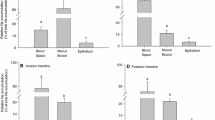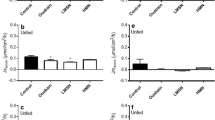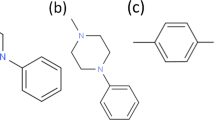Summary
Transmural fluxes of3H-mannitol and22Na or36Cl were measured simultaneously in portions of isolated turtle colon stripped of serosal musculature. The relationships between mannitol flux and the flux of Na or Cl are characteristic of simple diffusion and suggest that transmural mannitol flow is largely confined to a paracellular pathway where Na, Cl and mannitol move much as in free solution. The contribution of “edge damage” to the transmural mannitol flow appears to be minimal. Mucosal hyperosmolarity causes “blisters” in epithelial tight junctions and increases the diffusional permeability to Na and mannitol, suggesting that the rate-limiting barrier in the shunt path is the tight junction. If the total mucosa to serosa flux of Na is corrected for the portion traversing the shunt pathway it is apparent that changes in the short-circuit current are completely accounted for by the mucosa to serosal movement of Na through a cellular path. In addition, the serosa to mucosa flux of Na appears to be restricted to the shunt. These observations suggest that there is no appreciable “backflux” of Na through the active, cellular path. In the presence of 10−4 m amiloride the short-circuit current is markedly reduced and the mucosa to serosa Na flux is restricted to the shunt, so that the net Na flux is abolished. The small amiloride-insensitive short-circuit current is consistent with HCO3 secretion. Mucosa to serosa and serosa to mucosa fluxes of Cl appear to be largely restricted to the paracellular shunt path and there is no evidence for any net flow of Cl under short-circuit conditions. The total tissue conductance can be described as the sum of three components: a shunt conductance which is linearly related to the transmural mannitol flow, an “active” conductance which is linearly related to the short-circuit current and a small residual conductance. The shunt conductance is attributable to the diffusive movements of Na and Cl through the paracellular path. Variations in the active Na transport from tissue to tissue are largely attributable to variations in the apparent conductance of the active Na transport path. The driving force for active Na transport can be described as an apparent emf of approximately 130 mV. These results suggest that transmural mannitol flux provides a quantitative estimate of the ion permeability and electrical conductance of a paracellular shunt path across the isolated turtle colon and thereby facilitates the study of the transport characteristics and electrical properties of cellular paths for transepithelial solute movement.
Similar content being viewed by others
References
Binder, H.J., Rawlins, C.L. 1973. Electrolyte transport across isolated large intestinal mucosa.Am. J. Physiol. 225:1232
Bracho, H., Erlij, D., Martinez-Palomo, A. 1970. The site of the permeability barriers in frog skin epithelium.J. Physiol. (London) 213:50P
Carlinsky, N.J., Lew, V.L. 1970. Bicarbonate secretion and non-Na component of the short-circuit current in the isolated colonic mucosa ofBufo arenarium.J. Physiol. (London) 206:529
Civan, M.M. 1970. Effects of active sodium transport on current-voltage relationship of toad bladder.Am. J. Physiol. 219:234
Cofré, G., Crabbé, J. 1967. Active sodium transport by the colon ofBufo marinus: Stimulation by aldosterone and antidiuretic hormone.J. Physiol. (London) 188:177
Cooperstein, I.L., Hogben, C.A.M. 1959. Ionic transfer across the isolated frog large intestine.J. Gen. Physiol. 42:461
Dawson, D.C., Curran, P.F. 1976. Sodium transport by the colon ofbufo marinus: Na uptake across the mucosal border.J. Membrane Biol. 28:295
DiBona, D.R., Civan, M.M. 1973. Pathways for movement of ions and water across toad urinary bladder. I. Anatomic site of transepithelial shunt pathways.J. Membrane Biol. 12:101
Essig, A., Caplan, S.R. 1968. Energetics of active transport processesBiophys. J. 8:1434
Frizzell, R.A., Koch, M.J., Schultz, S.G. 1976. Ion transport by rabbit colon. I. Active and passive components.J. Membrane Biol. 27:297
Frizzell, R.A., Schultz, S.G. 1972. Ionic conductances of extracellular shunt pathway in rabbit ileum.J. Gen. Physiol. 59:318
Frömter, E. 1972. The route of passive ion movement through the epithelium ofnecturus gallbladder.J. Membrane Biol. 8:259
Frömter, E., Diamond, J.M. 1972. Route of passive ion permeation in epithelia.Nature New Biol. 235:9
Helman, S.I., Miller, D.A. 1973. Edge damage effect on electrical measurements of frog skin.Am. J. Physiol. 225:972
Helman, S.I., O'Neil, R.G., Fisher, R.S. 1975. Determination of theE Na of frog skin from studies of its current-voltage relationship.Am. J. Physiol. 229:947
Hong, C.D., Essig, A. 1976. Effects of 2-deoxy-d-glucose, amiloride, vasopressin, and ouabain on active conductance andE Na in the toad bladder.J. Membrane Biol. 28:121
Kedem, O. 1961. Criteria of active transport.In: Membrane Transport and Metabolism. A. Kleinzeller and A. Kotyk, editors. p. 87. Academic Press, New York
Kedem, O., Essig, A. 1965. Isotope flows and flux ratios in biological membranes.J. Gen. Physiol. 48:1047
Lanman, R.C., Burton, J.A., Schanker, L.C. 1971. Diffusion coefficients of some14C-labeled saccharides of biological interest.Life Sci. 10:803
Lew, V.L. 1970. Short-circuit current and ionic fluxes in the isolated colonic mucosa ofBufo arenarum.J. Physiol. (London) 206:509
Lewis, S.A., Diamond, J.M. 1976. Na+ transport by rabbit urinary bladder, a tight epithelium.J. Membrane Biol. 28:1
Loeschke, K., Bentzel, C.J., Csaky, T.Z. 1970. Assymetry of osmotic flow in frog intestine: Functional and structural correlation.Amer. J. Physiol. 218:1723
Mandel, L.J. 1975. Actions of external hypertonic urea, ADH, and theophylline on transcellular and extracellular solute permeabilities in frog skin.J. Gen. Physiol. 65:599
Mandel, L.J., Curran, P.F. 1972. Response of the frog skin to steady-state voltage clamping. I. The shunt pathway.J. Gen. Physiol. 59:503
Moreno, J.H., Diamond, J.M. 1974. Discrimination of movovalent inorganic cations by “tight” junctions of gallbladder epithelium.J. Membrane Biol. 15:277
Moreno, J.H., Diamond, J.M. 1975. Cation permeation mechanisms and cation selectivity in “tight junctions” of gallbladder epithelium.In: Membranes: A Series of Advances. G. Eisenman, editor. p. 383. Marcel Dekker, New York
Nellans, H.N., Frizzell, R.A., Schultz, S.G. 1974. Brush-border processes and transepithelial Na and Cl transport by rabbit ileum.Am. J. Physiol. 226:1131
Robinson, R.A., Stokes, R.H. 1965. Electrolyte Solutions, 2nd Edition, revised. Butterworths, London
Saito, T., Lief, P.D., Essig, A. 1974. Conductance of active and passive pathways in the toad bladder.Am. J. Physiol. 226:1265
Schultz, S.G., Frizzell, R.A., Nellans, H.N. 1974. Ion transport by mammalian small intestine.Annu. Rev. Physiol. 36:51
Schultz, S.G., Solomon, A.K. 1961. Determination of the effective hydrodynamic radii of small molecules by viscometry.J. Gen. Physiol. 44:1189
Schultz, S.G., Zalusky, R. 1964. Ion transport in isolated rabbit ileum. I. Short circuit current and Na fluxes.J. Gen. Physiol. 47:567
Thompson, S.M., Dawson, D.C. 1977. Direct measurement of Na entry across the apical cell membrane of the turtle colon: Confirmation of the two barrier model.Fed. Proc. 36:539
Ussing, H.H., Zerahn, K. 1951. Active transport of sodium as the source of electric current in the short-circuited isolated frog skin.Acta Physiol. Scand. 23:110
Whittemburgy, G., Rawlins, F.A. 1971. Evidence of a paracellular pathway for ion flow in the kidney proximal tubule. Electronmicroscopic demonstration of lanthanum precipitate in the tight junction.Pfluegers Arch. 330:302
Whittemburry, G., Rawlins, F.A., Boulpaep, E.L. 1973. Paracellular pathway in kidney tubules: Electrophysiological and morphological evidence.In: Transport Mechanisms in Epithelia. H. Ussing and N.A. Thorn, editors. p. 577. Munksgard, Copenhagen
Yonath, J., Civan, M.M. 1971. Determination of the driving force of the Na+ pump in toad bladder by means of vasopressin.J. Membrane Biol. 5:366
Author information
Authors and Affiliations
Rights and permissions
About this article
Cite this article
Dawson, D.C. Na and Cl transport across the isolated turtle colon: Parallel pathways for transmural ion movement. J. Membrain Biol. 37, 213–233 (1977). https://doi.org/10.1007/BF01940933
Received:
Issue Date:
DOI: https://doi.org/10.1007/BF01940933




